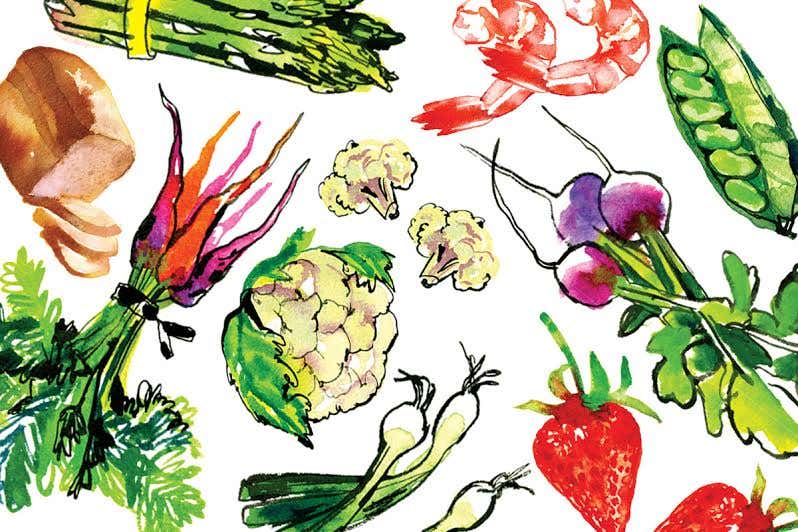
Tuesday Supper
I await Tuesdays the way a child anticipates Christmas morning. That's when the weekly farmers' market spills into the streets of our Provençal village, Vaison-la-Romaine. Hundreds of merchants arrive in town around six o'clock in the morning to set up their market stalls. No matter the season, there is always the arrival of some new ingredient to celebrate: black truffles in November, violet-hued baby artichokes in February, first-of-the-season asparagus and strawberries from nearby Carpentras in late March. And then, with summer, comes a veritable avalanche of produce: shiny purple eggplants; early, brilliant orange pumpkins known as potimarrons; new potatoes; snappy green beans; plump cloves of purple garlic; white beans known as cocos blancs; mountains of pungent arugula and multicolored mesclun; and more.
A holiday mood pervades Vaison-la-Romaine on Tuesdays. All of our friends know that they can find my husband, Walter, and me at the Universal Cafe come 10:00 a.m., with our espresso and our pain au chocolat. Sometimes our group takes up a series of tables, and we can easily spend the rest of the morning catching up on news. Local plumbers, masons, carpenters, and electricians never work Tuesday mornings and can be seen strolling the market, where they run into clients, who invariably stop them to say, "I meant to call you! My roof is leaking" (or "my cabinets need work," or "the electricity keeps going out in the bedroom"). No need for business cards here.
Most home cooks I know here take a holiday from cooking on Tuesdays because they want to linger at the market—and because they can always purchase a moist and crisp-skinned rotisserie chicken from the Laotian vendor, who also sells irresistible fresh summer rolls and tiny nems, or fried spring rolls. The women might buy a wood oven-fired pizza from one of the pizza trucks that appear on the streets on market day, or a fougasse, the ladderlike yeast bread garnished with olives or capers or pork cracklings (see ** Fougasse**). Or they might settle on a meal of cheese and salad after visiting one of the goat cheese merchants, many of them aging hippies who abandoned Paris for Provence in the 1960s. Our fishmongers, Eliane and Aymer Beringer, sell an array of prepared fish and shellfish, including garlicky salt cod brandade, marinated sardines, and beautiful platters of gravlax. And our butcher, Gilles Digle, and his wife, Severine, always have plenty of their signature saucisson aux olives, a fresh pork sausage studded with the meaty, wrinkled olives known as_ olives de Nyons_.
Although I've lived in Provence for 30 years now, I have never adopted the custom of taking a break from cooking on Tuesdays. I can't: I always end up buying far too much as I make my way from market stall to market stall. If I see a particularly alluring display of ripe heirloom tomatoes, I tell myself that there is always room for another batch of tomates provençales. It's a preparation that shows off the season's crop to its best advantage: I begin by searing the tomatoes to seal in their juices, and then I set them aside in an earthenware baking dish. Next I deglaze the pan with vinegar, reducing the cooking liquid to a tart, savory sauce that I'll drizzle over the tomatoes before baking them until they are soft, luscious, and black around the edges. And since I'm in the kitchen anyway, I might as well bake a round of pompe a l'huile, the olive oil brioche we favor in this part of France, for the next day's breakfast. What better match for the seductive lavender honey I've picked up on my rounds, or one of the jams I've put up to preserve the fruits from previous market forays?
A vegetable ragout is always on our menu this time of year (see ** Vegetable Ragout with Pesto**). It's a perfect way to use up everything I haul away in my wicker shopping cart: purple-tipped poivrade artichokes, maybe, and some plump fava beans, last-of-the-season peas, and the year's final crop of firm white asparagus. I like to make a sauce au pistou—a bright, fresh Provençal pesto—to add to the ragout, so I buy a giant flower pot of basilic marseillais, the sharp and peppery basil traditionally used to make the sauce. After sweating onions in a skillet until they become translucent, I add the artichokes, the fava beans, the asparagus, and some freshly shelled peas and simmer them in a cup or two of white wine for about ten minutes. That's as long as it takes to soften the vegetables slightly, and the wine's acidity works brilliantly to marry the varied flavors of into a coherent whole. Topped with a generous dollop of sauce au pistou, this is summer on a plate.
While I prepare the vegetable ragout, my husband sets to work on the lamb chops that Gilles Digle has sliced off for us in tiny single ribs (see ** Lemon-Thyme Lamb Chops**). He marinates them in a bright mixture of lemon juice, fruity green olive oil, and fresh lemon thyme, which will ensure that the delicate meat remains moist and succulent during cooking and will also prevent it from sticking to the grill. (We never salt the meat before cooking, as that would draw out its flavorful juices.) Then Walter grills the marinated lamb chops over sarments de vigne, clippings from grapevines that we grow on our property. No summertime meal in Provence would be complete without a glass of local rose—our favorite is the Tavel from Domaine de la Mordoree, which is bracingly dry yet redolent of strawberries—or a lusty tapenade made from those meaty, salty_ olives de Nyons_. As we sit down to eat, I am already thinking of next Tuesday. —Patricia Wells, author of We've Always Had Paris…And Provence_ (HarperCollins, 2008)_
Keep Reading
Continue to Next Story










